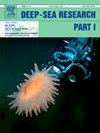南极布兰斯菲尔德海峡夏季环流和水团输送:对南环模和El Niño-Southern振荡联合效应的响应评价
IF 2.3
3区 地球科学
Q2 OCEANOGRAPHY
Deep-Sea Research Part I-Oceanographic Research Papers
Pub Date : 2025-05-10
DOI:10.1016/j.dsr.2025.104516
引用次数: 0
摘要
布兰斯菲尔德海峡位于南极半岛北部,是研究气候变化影响的关键区域。这种复杂性源于不同水团的汇合:威德尔影响的过渡带水(TWW)和别令斯豪森影响的过渡带水(TBW)。本研究旨在通过2003 - 2019年高质量水文资料、高度计资料和全球涡旋解析海洋再分析产品GLORYS12v1,对布兰斯菲尔德海峡夏季环流进行长期描述。结果表明,布兰斯菲尔德海峡内的海洋环流为气旋型,其特征是布兰斯菲尔德洋流沿南设得兰群岛向东北方向延伸至大象岛,西南方向的南极海岸洋流进入62.40°S和55.00°W附近。gloys12v1和高测数据集显示:部分布兰斯菲尔德流离开乔治国王岛和克拉伦斯群岛之间的东部盆地,并在南设得兰群岛周围再循环,并提供了第一个可靠的估计,在很长一段时间内,TBW在乔治国王岛和象岛之间运输并供给布兰斯菲尔德流。我们的研究结果强调了TBW传输强度与气候模式变率之间的联系,量化了它们的强度和变率,这是由南环模和El Niño-Southern振荡指数(统称为SEI指数)的联合效应引起的风强迫调制。例如,SEI负条件的时间平均年显示,进入乔治国王岛和象岛之间的布兰斯菲尔德海峡的TBW为0.10 Sv。另一方面,在SEI正条件下,TBW输运增加到0.31 Sv。这些观测到的变化对于提高我们对区域环流模式及其潜在机制的理解至关重要,因为它们直接影响该区域的物理和生物地球化学特性。本文章由计算机程序翻译,如有差异,请以英文原文为准。
Summer circulation and water masses transport in Bransfield Strait, Antarctica: An evaluation of their response to combined effects of Southern Annular Mode and El Niño–Southern Oscillation
Bransfield Strait, situated in the northern Antarctic Peninsula, is a critical area for studying the impacts of climate change. This complexity arises from the convergence of distinct water masses: Transitional Zonal Water with Weddell influence (TWW), and Transitional Zonal Water with Bellingshausen influence (TBW). This study aims to give a long–term description of Bransfield Strait circulation during austral summers through high-quality hydrographic data from 2003 to 2019, altimetry data and the global eddy–resolving ocean reanalysis product GLORYS12v1. Findings reveal a cyclonic ocean circulation pattern within Bransfield Strait, characterized by the northeastward Bransfield Current along the South Shetland Islands and extending to Elephant Island, and the southwestward Antarctic Coastal Current entering near 62.40°S and 55.00°W. GLORYS12v1 and altimetry datasets revealed that: part of the Bransfield Current leaves the eastern basin between King George and Clarence Islands and recirculation around the South Shetland Islands, and provides the first robust estimate over an extended period that TBW is transported between King George and Elephant Islands and feeds Bransfield Current. Our results highlight links between the strength of TBW transport and variability in climate modes, quantifying their magnitude and variability due to wind forcing modulation by combined effects of Southern Annular Mode and El Niño–Southern Oscillation indices (jointly called the SEI index). For instance, time-averaged years of SEI negative conditions reveal 0.10 Sv of TBW entering the Bransfield Strait between King George and Elephant Islands. On the other hand, under SEI positive conditions, the TBW transport increases to 0.31 Sv. These observed changes are crucial for advancing our understanding of regional circulation patterns and their underlying mechanisms, as they directly influence the physical and biogeochemical properties of the region.
求助全文
通过发布文献求助,成功后即可免费获取论文全文。
去求助
来源期刊
CiteScore
4.60
自引率
4.20%
发文量
144
审稿时长
18.3 weeks
期刊介绍:
Deep-Sea Research Part I: Oceanographic Research Papers is devoted to the publication of the results of original scientific research, including theoretical work of evident oceanographic applicability; and the solution of instrumental or methodological problems with evidence of successful use. The journal is distinguished by its interdisciplinary nature and its breadth, covering the geological, physical, chemical and biological aspects of the ocean and its boundaries with the sea floor and the atmosphere. In addition to regular "Research Papers" and "Instruments and Methods" papers, briefer communications may be published as "Notes". Supplemental matter, such as extensive data tables or graphs and multimedia content, may be published as electronic appendices.

 求助内容:
求助内容: 应助结果提醒方式:
应助结果提醒方式:


